Intrauterine Growth Restriction: Hungry for an Answer
- PMID: 26889018
- PMCID: PMC4895444
- DOI: 10.1152/physiol.00033.2015
Intrauterine Growth Restriction: Hungry for an Answer
Abstract
Intrauterine growth restriction (IUGR) has been defined in several ways, but in general describes a condition in which the fetus exhibits poor growth in utero. This complication of pregnancy poses a significant public health burden as well as increased morbidity and mortality for the offspring. In human IUGR, alteration in fetal glucose and insulin homeostasis occurs in an effort to conserve energy and survive at the expense of fetal growth in an environment of inadequate nutrient provision. Several animal models of IUGR have been utilized to study the effects of IUGR on fetal glucose handling, as well as the postnatal reprogramming of energy metabolite handling, which may be unmasked in adulthood as a maladaptive propensity for cardiometabolic disease. This developmental programming may be mediated in part by epigenetic modification of essential regulators of glucose homeostasis. Several pharmacological therapies and nonpharmacological lifestyle modifications have shown early promise in mitigating the risk for or severity of adult metabolic phenotypes but still require further study of unanticipated and/or untoward side effects.
©2016 Int. Union Physiol. Sci./Am. Physiol. Soc.
Conflict of interest statement
No conflicts of interest, financial or otherwise, are declared by the author(s).
Figures



References
-
- Acevedo CG, Marquez JL, Rojas S, Bravo I. Insulin and nitric oxide stimulates glucose transport in human placenta. Life Sci 76: 2643–2653, 2005. - PubMed
-
- Adam CL, Bake T, Findlay PA, Milne JS, Aitken RP, Wallace JM. Impact on birth weight and gender on early postnatal hypothalamic energy balance regulatory gene expression in the young lamb. Int J Dev Neurosci 31: 608–615, 2013. - PubMed
-
- Battista MC, Oligny LL, St-Louis J, Brochu M. Intrauterine growth restriction in rats is associated with hypertension and renal dysfunction in adulthood. Am J Physiol Endocrinol Metab 283: E124–E131, 2002. - PubMed
Publication types
MeSH terms
Substances
Grants and funding
LinkOut - more resources
Full Text Sources
Other Literature Sources
Medical

